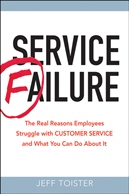Why you need to view service through your customers' eyes
 Jeff Toister
Jeff Toister  Tuesday, November 27, 2012 at 1:00PM |
Tuesday, November 27, 2012 at 1:00PM | This sign greeted me as I entered a parking lot on a recent Tuesday morning:
I chuckled as I imagined what someone might think if they didn’t realize that Tuesday Morning was the name of a store. Yes, that scenario seems a bit far-fetched, but it’s a good reminder that customers can often view a situation in different or even unexpected ways.
This is a topic I’ve blogged about before. Two years ago, I shared a post about a sign taped to an ice cream cooler that either advertised a nice selection or the worst flavor imaginable (Seeing things from the customer’s perspective). This time around, I’ll relay a story from a friend of mine plus share a few strategies I use for gaining customer insight.
"You're no longer welcome"
A friend of mine recently posted an update on her Facebook page complaining that she had been refused an appointment at her hair salon. Apparently, she had been a no-show for an average of 1 in 9 appointments, so the hair salon finally decided to turn away her business. From the salon’s point of view, no-shows cost them money since that appointment slot would otherwise have been filled, so it made sense to cut loose an unreliable customer.
However, I doubt the hair salon considered my friend’s perspective when they made their decision or when they delivered the message. Predictably, she was quite angry to be abruptly told she was no longer welcome. It also made her remember the poor service she had received on her last visit, where she had previously forgotten about it because overall she really liked the place. Her post on Facebook drew many supportive comments and offers to refer her to another hair dresser.
How to see through the customers’ eyes
The challenge is our customers’ perspective is often only obvious in hindsight. It takes consistent, deliberate effort to really get inside your customers’ heads before a service failure occurs. Here are a few techniques you can use:
Teach empathy. The ability to empathize with another person comes from having a relatable experience, but customer service employees often have difficulty relating to their customers. Through proper training, employees can learn techniques to see things from their customers’ point of view (see 5 Ways to help employees empathize more).
Dig deep into survey data. The problem with a lot of customer survey data is it’s presented in aggregate, but those averages don’t tell the full story. For example, a client mined their survey data and discovered that one particular problem accounted for the overwhelming majority of customer dissatisfaction.
Look for icebergs. It’s easy to dismiss strange feedback as an isolated incident involving a confused and disoriented customer. However, in some cases this feedback may be just the tip of the iceberg. A favorite technique of mine involves digging deeper to see if there’s a systematic problem (see What the FAA can teach us about icebergs).





